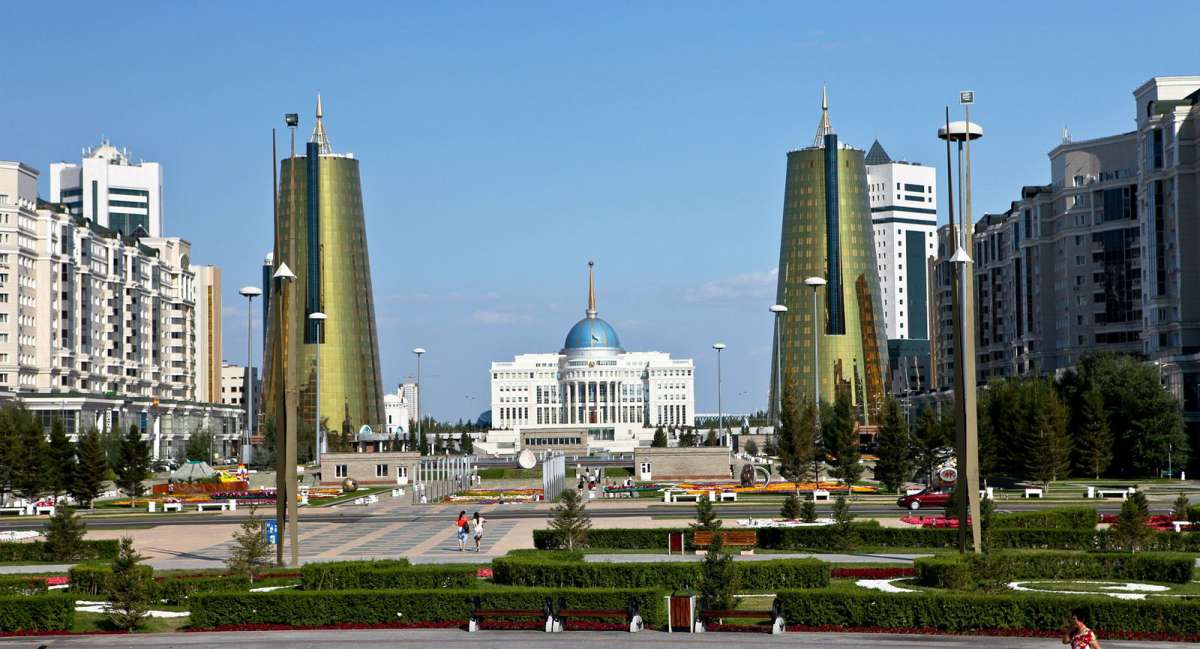For hundreds of years the nomads of Central Asia roamed over an enormous territory that stretched from the Caspian Sea to the Tien Shen mountains and as far south as Afghanistan.
Fought over, at first by the three dzus or clans known in the West as the Great, Middle and Little Hordes, and then annexed by the Soviets, Kazakhstan remained an enigma, its vast size – roughly that of western Europe – and inaccessibility put it beyond the reach of all but the most adventurous of travellers.
In Xanadu did Kublai Khan an ancient pleasure dome decree…
The Xanadu of Samuel Taylor Coleridge’s poem was a ‘savage and enchanted’ land of sacred rivers, caves of ice and ‘twice five miles of fertile ground’. It is almost as if his words were written for Kazakhstan whose rivers and holy places were sacred to the pre-Islamic shamanistic society that once dwelt there.
And 200 years after Coleridge wrote the opening lines, the country is itself opening up. Thousands of miles of plains, mountains and glaciers, stunning canyons and natural monuments shaped by the wind, ancient cave paintings and glyphs can still be seen – as can modern cities complete with entertainment centres and shopping malls, built from scratch in the middle of the steppe.
Astana

Downtown Astana (c) wikimedia/Ken and Nyetta
Astana, the new capital is President Nursultan Nazabayev’s Xanadu. Once a quiet trading post on the fringes of the silk route, for the past ten years it has been the country’s new capital and the population has exploded as people move to the city to work and study. There’s something slightly surreal about watching a city take shape in front of your eyes, vast construction projects are everywhere and even at night one can hear the sound of building.
Last year, the President inaugurated the Palace of Peace, an enormous glass pyramid built by the British architect Norman Foster. Surprisingly tardis-like it holds an opera house and on its upper floors, there are meeting rooms, office space and at the top, a curious, blindingly white conference suite with incredible panoramic views across the city.

Palace of Peace, Astana, Kazakhstan (c) flickr/Ken & Nyetta
In keeping with the feeling of other-worldliness that permeates the place, the glass has been tinted and giant doves, the size of cows have been printed onto the windows. At least the sky is always blue for the lucky conference goers who have to walk up through a lush ‘sky garden’ to reach the eyrie. Only the president, says our guide, is allowed to use the lift all the way to the top.
From October to April, the ground is almost entirely covered with deep snow. While this makes getting around Astana tricky enough – it is certainly not a city designed with pedestrians in mind – it is an excellent time of the year to visit. The River Ishim which runs through the centre of the city is frozen solid and plays host to a number of skiers, walkers. There are also ice fishermen who huddle under home made plastic windbreaks which cover the entire body while they wait to catch tiny fry for bait.
But the most fun with ice is surely that on offer at the free ice-sculpture park where adults and children alike take great pleasure in the massive sculptures, some of which are big enough to climb up and slide down. Night-time, when the sculptures are illuminated (like everything else in this city where the lights are always on) is the most popular time for families. It isn’t unusual to find groups of friends playing hide and seek among the exhibits and good naturedly helping each other on the slides.
Modern architecture buffs will find plenty of interest in Astana. A substantial part of the city is being rebuilt, at the president’s behest to provide space for a new capital worthy of a nation with a significant amount of oil reserves. A vast new presidential office and the parliament have already been finished and new areas for civil servants, diplomats and businesses are planned.
Almaty
But until Astana becomes less of a building site, the jewell in the crown will still be Almaty. The country’s biggest city’s more human scale and its more varied architecture imbue it with a sense of reality that Astana seems determined to eschew.

Almaty leafy boulevard (c) wikimedia/Sofi Kan
In the summer Almaty’s wide, leafy boulevards take on a European air. Cafes spring up and the streets buzz with people. But a winter visit can be tremendously rewarding for those prepared to wrap up well.
Walking really is the best way to explore Almaty. Unlike Astana where someone clearly forgot to include pedestrians in the master plan, Almaty has pavements which one can still usually find in spite of the piles of snow dumped each morning at the roadside by the snow ploughs. Kazakhs of course don’t seem to find it difficult to negotiate. Women in incredible floor length furs, skintight jeans and eight inch stiletto heels negotiate the huge piles of snow at the side of the road with barely a second glance.
Public transport exists – for those who can master the bus system but this is still a city where anyone who can prefers to drive. Taxis are plentiful (except in the afternoon rush hour) but an informal system also operates and if you stick out a hand someone will almost certainly stop and invite you – for a price best negotiated at the roadside – to hop in.
When the Panfilov Park, the largest green space in the heart of the city is covered with a thick layer of freshly fallen snow and icicles hang from the trees, the scene is of a winter wonderland. Not surprisingly, on Sundays it is a favourite destination for families. Parents haul children on traditional, home made sledges to feed the pigeons in the square in front of the Russian Orthodox cathedral, one of the loveliest buildings in the whole city.

Russian Orhodox Cathedral in Panfilov Park, Almaty (c) flickr/Alex J. Butler
Constructed entirely of wood, without a single nail, the church is a colourful confection of brightly painted domes topped with crosses that glint in the sunlight. If you are lucky, you might catch sight of a wedding party or a soberly dressed but smiling priest hurrying inside where the all enveloping warmth and the scent of candles is intoxicating.
Weekends tend to be when families get together and another popular place for meeting is the Medeo skating rink. Only a short drive from the centre of Almaty, Medeo is a favoured hangout, especially for groups of young people and on a clear day, the location, overlooking the city affords spectacular views.
Cuisine
Kazakhs have a rich cultural heritage and the city’s museum is not to be missed. It is a vast building, with particularly good displays of ethnography and beautiful textiles from the country’s nomadic past including beautifully carved bowls and ladles for serving kumyss, the traditional drink of mare’s milk and chubut, fermented camel milk. A few of the displays have short English descriptions.
If you fancy trying kumyss for yourself, the Green Market is the place to go. As its name suggests, it is the main source for fresh produce and is still very popular in spite of the supermarkets which have opened in the city in the last few years.

Fruit vendor at the Green Bazaar, Almaty, Kazakhstan (c) flickr/Sara Yeomans
A stroll through the different sections, gives a good insight into the incredible variety that is available.
Here you can buy plump, juicy apricots and figs, delicious Korean salads (there’s been an established Korean community here since WWII) huge apples – the modern relative of the rare ‘variety’ that gave the city its name and, in a special section, pretty much any type of horsemeat, including kazy, a local equine sausage.
The traditional Kazakh meal, besbarmek is eaten on special occasions such as Nourouz – the New Year celebration held in late March. It can be hard to find at other times so if you are offered the chance to try it, don’t miss it (unless you are vegetarian).
Non meat eaters may find Kazakhstan something of a challenge – this is a country where ‘meaty salads’ abound. But sometimes the most exquisite gastronomic pleasures are the ones you least expect, stopping at a roadside foodstall we ate the most delicious shashlik – a gilled skewer of tender lamb with fresh warm bread and generous helpings of plov – the ubiquitous rice dish made with meat and raisins which can be a meal in itself.
Almaty isn’t short of restaurants but finding them (commercial premises off the beaten track are often hidden away inside other buildings) can, to the visitor used to brightly lit shop fronts, be hard to find. It is definitely worth asking for recommendations as places change.
Nature
But it is Kazakhstan’s endless steppe – and the biodiversity that flourishes there that that must be the highlight of a visit. Three hours from Almaty, the Charryn Canyon is an extraordinary depression that runs for almost 150 miles. With the snow capped mountains that mark the border with China and the deep ochres and reds of the sandstone in the canyon it is one of the country’s most impressive sights. The drive follows a road that leaves Almaty passing first the last few wooden houses in the city with original snowboards decorated with filigree patterns, and then through numerous small auls or tiny villages where the most people earn their living from growing and drying tobacco.

Kazakh falconer with golden eagle (c) flickr/Nurgeldy
Suddenly the great cities seem far behind. Here you can still find berkutchis – traditional falconers who still hunt with golden eagles. Near Sugat, a small aul on the way to Charryn, there is a tiny museum dedicated to falconry. The owner is a prize-winning berkut and can arrange demonstrations and hunting trips for enthusiasts.
It is impossible not to be inspired by the size and stark beauty of this little understood country – and its people who are warm and generous even when a language barrier makes everyday communication a little more challenging. It’s hard not to fall in love with Kazakhstan – you might even be inspired to try a little poetry yourself.
Useful links
I flew Air Astana direct to Almaty from London and to Astana via Amsterdam. Prices start from £299.00 plus tax. Air Astana also operates several daily shuttle services to from Almaty to the major cities in the country. Holders of Air Astana tickets can also make use of the new express visa service allowing UK passport holders to process their visa in one day if they apply in person at the consulates in London or Aberdeen.
I stayed in Hotel Kazakhstan which has double rooms from £80.00 plus tax including breakfast.
There is no official tourist office in the UK but Almaty-based Kantengri Tours works with several tour operators including Naturetrek, which has a nine-night birdwatching and adventure trip leaving each Spring from £1,400 per person including flights and B&B accommodation.
In Astana, Sayat Travel can arrange tours of the city and excursions to nearby lakes with English-speaking guides.
According to the World Land Trust carbon calculator, a return journey from the UK to Kazakhstan would generate 1.05 tonnes of carbon emissions. To offset with WLT for this journey costs £10.25.
Guidebook: Lonely Planet: central Asia
Need to know
Time Difference: GMT + 4/5 hours
Flight Time from the UK: Seven hours
Currency: Tenge (£1= 250 Tenge)
Language: Russian is spoken everywhere but Kazakh is making a comeback. English is spoken in the larger hotels in the main cities.
Entry Visa: UK nationals do require a visa. You will need a valid passport (6 months upon exit), one clear page in your passport, one passport sized photograph and one completed application form in block capitals. www.thevisacompany.com


